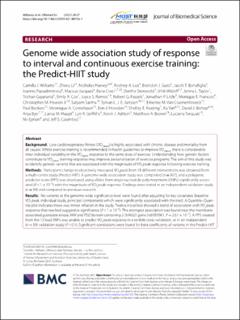| dc.contributor.author | Williams, Camilla J. | |
| dc.contributor.author | Li, Zhixiu | |
| dc.contributor.author | Harvey, Nicholas | |
| dc.contributor.author | Lea, Rodney A. | |
| dc.contributor.author | Gurd, Brendon J. | |
| dc.contributor.author | Bonafiglia, Jacob T. | |
| dc.contributor.author | Papadimitriou, Ioannis | |
| dc.contributor.author | Jacques, Macsue | |
| dc.contributor.author | Croci, Ilaria | |
| dc.contributor.author | Stensvold, Dorthe | |
| dc.contributor.author | Wisløff, Ulrik | |
| dc.contributor.author | Taylor, Jenna L. | |
| dc.contributor.author | Gajanand, Trishan | |
| dc.contributor.author | Cox, Emily R. | |
| dc.contributor.author | Ramos, Joyce S. | |
| dc.contributor.author | Fassett, Robert G. | |
| dc.contributor.author | Little, Jonathan P. | |
| dc.contributor.author | Francois, Monique E. | |
| dc.contributor.author | Hearon, Christopher M. | |
| dc.contributor.author | Sarma, Satyam | |
| dc.contributor.author | Janssen, Sylvan L.J.E. | |
| dc.contributor.author | Van Craenenbroeck, Emeline M. | |
| dc.contributor.author | Beckers, Paul | |
| dc.contributor.author | Cornelissen, Véronique A. | |
| dc.contributor.author | Howden, Erin J. | |
| dc.contributor.author | Keating, Shelley E. | |
| dc.contributor.author | Yan, Xu | |
| dc.contributor.author | Bishop, David J. | |
| dc.contributor.author | Bye, Anja | |
| dc.contributor.author | Haupt, Larisa M. | |
| dc.contributor.author | Griffiths, Lyn R. | |
| dc.contributor.author | Ashton, Kevin J. | |
| dc.contributor.author | Brown, Matthew A. | |
| dc.contributor.author | Torquati, Luciana | |
| dc.contributor.author | Eynon, Nir | |
| dc.contributor.author | Coombes, Jeff S. | |
| dc.date.accessioned | 2023-01-12T09:09:12Z | |
| dc.date.available | 2023-01-12T09:09:12Z | |
| dc.date.created | 2021-12-07T13:15:39Z | |
| dc.date.issued | 2021 | |
| dc.identifier.citation | Journal of Biomedical Science. 2021, 28 (1), . | en_US |
| dc.identifier.issn | 1021-7770 | |
| dc.identifier.uri | https://hdl.handle.net/11250/3042896 | |
| dc.description.abstract | Background
Low cardiorespiratory fitness (V̇O2peak) is highly associated with chronic disease and mortality from all causes. Whilst exercise training is recommended in health guidelines to improve V̇O2peak, there is considerable inter-individual variability in the V̇O2peak response to the same dose of exercise. Understanding how genetic factors contribute to V̇O2peak training response may improve personalisation of exercise programs. The aim of this study was to identify genetic variants that are associated with the magnitude of V̇O2peak response following exercise training.
Methods
Participant change in objectively measured V̇O2peak from 18 different interventions was obtained from a multi-centre study (Predict-HIIT). A genome-wide association study was completed (n = 507), and a polygenic predictor score (PPS) was developed using alleles from single nucleotide polymorphisms (SNPs) significantly associated (P < 1 × 10–5) with the magnitude of V̇O2peak response. Findings were tested in an independent validation study (n = 39) and compared to previous research.
Results
No variants at the genome-wide significance level were found after adjusting for key covariates (baseline V̇O2peak, individual study, principal components which were significantly associated with the trait). A Quantile–Quantile plot indicates there was minor inflation in the study. Twelve novel loci showed a trend of association with V̇O2peak response that reached suggestive significance (P < 1 × 10–5). The strongest association was found near the membrane associated guanylate kinase, WW and PDZ domain containing 2 (MAGI2) gene (rs6959961, P = 2.61 × 10–7). A PPS created from the 12 lead SNPs was unable to predict V̇O2peak response in a tenfold cross validation, or in an independent (n = 39) validation study (P > 0.1). Significant correlations were found for beta coefficients of variants in the Predict-HIIT (P < 1 × 10–4) and the validation study (P < × 10–6), indicating that general effects of the loci exist, and that with a higher statistical power, more significant genetic associations may become apparent.
Conclusions
Ongoing research and validation of current and previous findings is needed to determine if genetics does play a large role in V̇O2peak response variance, and whether genomic predictors for V̇O2peak response trainability can inform evidence-based clinical practice. | en_US |
| dc.language.iso | eng | en_US |
| dc.publisher | BMC | en_US |
| dc.rights | Navngivelse 4.0 Internasjonal | * |
| dc.rights.uri | http://creativecommons.org/licenses/by/4.0/deed.no | * |
| dc.title | Genome wide association study of response to interval and continuous exercise training: the Predict-HIIT study | en_US |
| dc.title.alternative | Genome wide association study of response to interval and continuous exercise training: the Predict-HIIT study | en_US |
| dc.type | Peer reviewed | en_US |
| dc.type | Journal article | en_US |
| dc.description.version | publishedVersion | en_US |
| dc.source.pagenumber | 0 | en_US |
| dc.source.volume | 28 | en_US |
| dc.source.journal | Journal of Biomedical Science | en_US |
| dc.source.issue | 1 | en_US |
| dc.identifier.doi | 10.1186/s12929-021-00733-7 | |
| dc.identifier.cristin | 1965589 | |
| cristin.ispublished | true | |
| cristin.fulltext | original | |
| cristin.qualitycode | 1 | |

